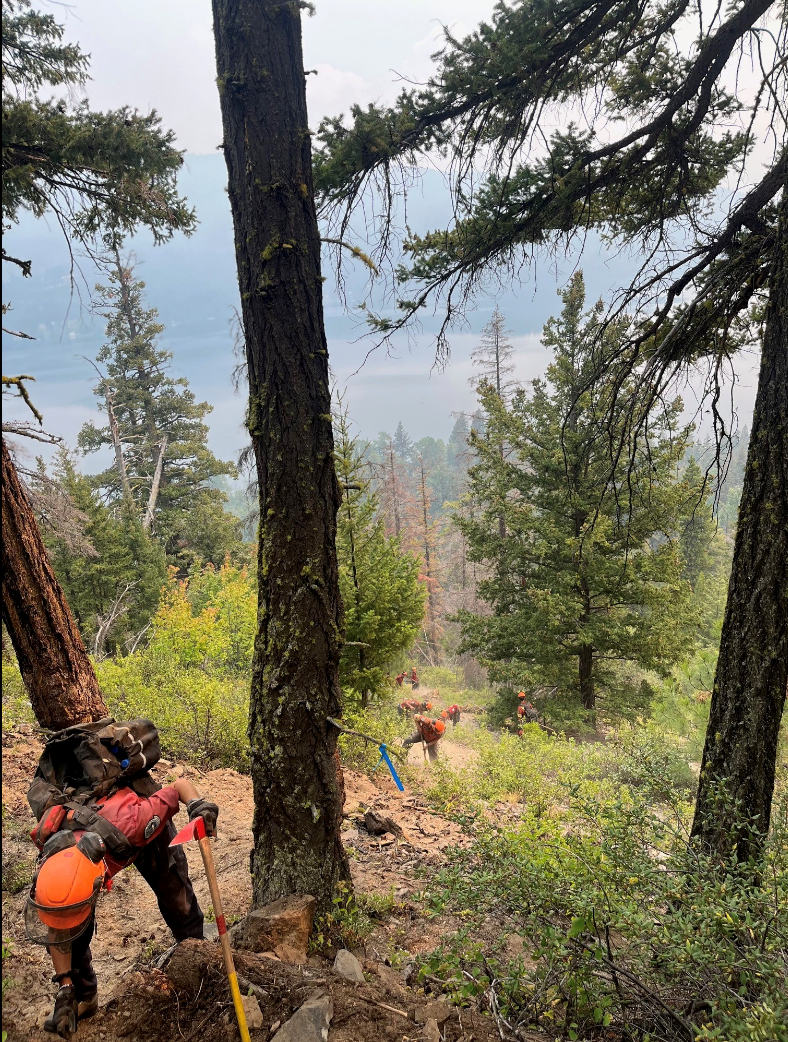After a brief reprieve of rain last week, the recent heat wave spiking temperatures across B.C. did no favours for a pair of wildfires burning out of control in the Squamish-Lillooet Regional District (SLRD).
“It’s certainly a concern with no rain in the forecast. This persistent heat is not good by all accounts that we’re hearing from BC Wildfire and all the authorities on that,” said SLRD board chair Jen Ford.
On Wednesday, the Casper Creek wildfire that ignited last month near Anderson Lake, west of Lillooet, was at an estimated 4,650 hectares, according to the BC Wildfire Service. By Friday morning, it grew to 6,520 hectares.
With temperatures climbing into the mid-30s C this week, the provincial agency said an increase to fire activity—behind established fire guards—and visible smoke was likely. Water-bucketing helicopters will continue to be assigned to the site to assist as required. On Wednesday, Environment Canada issued a special weather statement for much of B.C.—including Whistler and Pemberton—warning gusty winds and dry lighting brought on by a cold front sweeping across the province Thursday could worsen wildfire conditions.
If there was a silver lining to the smoke clouds, it’s that last week’s favourable conditions were enough to allow the SLRD to rescind its evacuation order, on Aug. 9, that had been in place since July 22 for properties located from Highline Road to the Seton Portage area.
An evacuation alert has been issued in its place, and applies to all properties from north of Connel Creek to Seton Portage, along with all properties in Seton Portage itself. On Thursday, the SLRD issued an expanded evacuation alert for all properties in the Yalakom Valley and Bridge River Valley areas.
The evacuation alert issued by the Tsal’alh First Nation remains in place.
The same can’t be said for the Downton Lake wildfire, in the vicinity of Mount Penrose. The Aug. 1 evacuation order for properties in the area of Gun Lake and Lajoie Lake remains in place. On Thursday, Aug. 17, officials issued a new evacuation order for all properties in the Slim Creek, Tyaughton Lake and Gun Creek Road areas, and an evacuation alert for areas north of Carpenter and Marshall Lakes.
Earlier this month, on Aug. 2, the district expanded its evacuation alert for all properties from Gold Bridge to Brexton, south towards Gwyneth Lake Resource Road, as well as properties north of Tyaughton Lake.
According to the BC Wildfire Service, firefighters have now successfully implemented a planned ignition along the northeastern extent of the fire, bringing it down to established guards. Crews can now directly access the fire’s edge and complete mop-up efforts to “consolidate this containment,” which the service said was “an important step” in being able to rescind or modify evacuation orders and alerts in the future. Smoke from the planned ignition may remain visible from surrounding areas as remaining pockets of forest burn out.
Due to the deep-seated nature of the remaining hotspots, the service said guard consolidation and mop-up work would continue for a number of days, likely long enough for the thunderstorms, dry lightning, and gusty winds in the forecast for Aug. 17 and 18 to add to the challenge of fire suppression.
On Aug. 11, the SLRD released an FAQ answering common questions about the Downton Lake fire and evacuation procedures.
Combined, the Casper Creek and Downton Lake fires make up 9,123 ha.—the rough equivalent of 186 West Edmonton Malls.
“We’re always aware of the fire risk because we are in the middle of the forest, and this summer being so, so dry, it’s really scary,” said former Whistler Mayor Nancy Wilhelm-Morden, whose family has a cottage in McGillivray, about 10 kilometres from the Casper Creek wildfire. “We do a lot of management of our property. The families here are always making sure trees directly adjacent to our properties are trim and we keep the tall grasses clear … to mitigate the risk as best we can. It’s a worry, and I fear it’s only going to get worse in the future.”
Even as swaths of B.C. burn during the province’s worst fire season on record, Whistler and the rest of the Sea to Sky have been fortunate enough to avoid a major wildfire. Wilhelm-Morden, who emailed the Mayor of Lahaina, Hawaii following the devastating fire that claimed dozens of lives last week, believes there are key takeaways Whistler and the corridor can take from that emergency, like “what happens when the electricity goes down and there’s a lack of communication?” she relayed. “How do we make people aware of the risk and get them out in a timely fashion? The combination of wind and drought is something Whistler has got to be aware of.”
The SLRD launched its new emergency notification system, SLRD Alert, last year, replacing a previous system with improved access, speed, and delivery of notifications via app, telephone, text or email. Sign up here.



